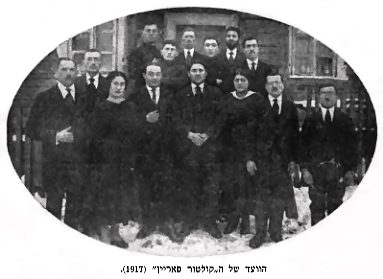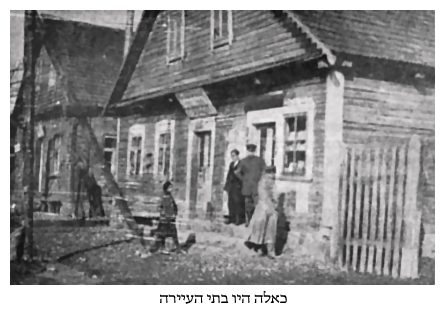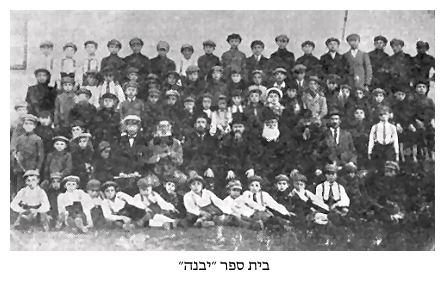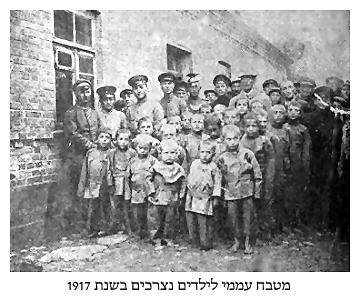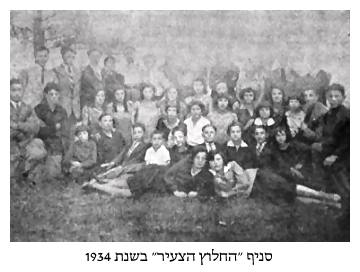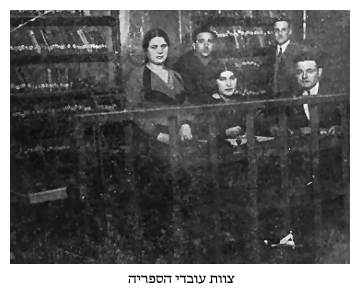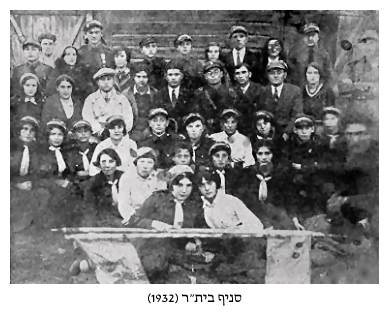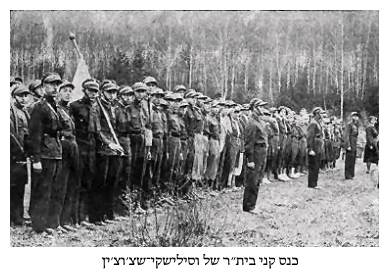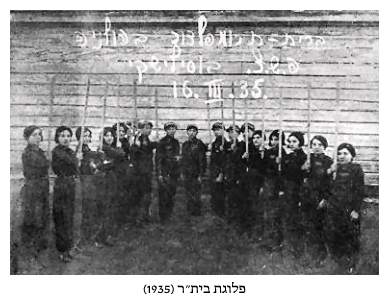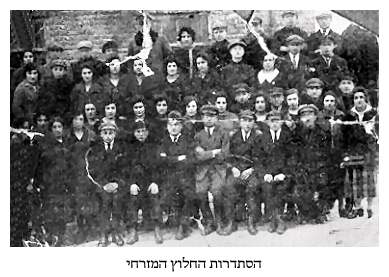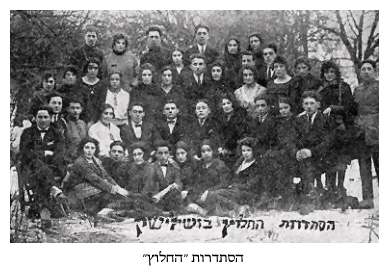[Page 132]
The Committee of the Society
for Jewish Culture (1917)
by Dr. A. Foshter
Translated by Robert Moretsky
The Society was established in 1916 at the time of the German occupation and
existed for several years. As a byproduct of the war conditions, this small
village was disconnected even from the immediate surrounding area. A circle of
intellectuals and dignitaries felt the need to establish a society of Jewish
culture in order to enliven a little spirit and social activity into the lives
of the young people in the town and to find an outlet for their public work.
The society would hold evening lectures about different topics or would do
readings from Jewish literature. Balls and social parties took place in town
and under this society, a drama group was established. This drama group
performed a few theatre shows.
In the year 1917, scattered news began to arrive from the larger cities in the
area about the political aspirations of the Jewish groups to establish (new)
autonomous communities and to reorganize the Zionist movement. In light of
these changes, there was hope and an awakening regarding the changes in the
political situation in the Land of Israel. The different groups in Vasilishki
absorbed the new waves “blowing” in the Jewish world and added into
their realm of activity, discussions about these political questions. The
occupying authorities forbade these activities. One could say that these
activities helped in the development of the Zionist parties in the village
after the end of the war.
|
|
The Committee of the Society for Jewish Culture (1917)
From left, first row: Alter Schwartz, Simchah Ketook, Sarah Gordon, Yaacov Koifman, Azreil Sveitisky,
(chairman of the committee), Breinah Orliansky, Baruch Kolbarsky, Kalman Vasilsky
Second row: Avraham Vasilsky, Asher Foshter, Alter Lis
Last row: Mendel Mashevsky, Avraham Boyarsky, Yehoshoah Miller
Among the members still alive: Kalman Vasilsky (now Dagni) in Afula,
Asher Foshter (now Foster) in Tel Aviv,
Mendel Mashevsky in New York |
[Page 133]
The Magnificent Past of Teaching
the Torah in Our Dear Village
by Rabbi Shimon Ram
Translated by Robert Moretsky
A tragic literature imbued with gloomy sorrow comes up and blossoms during our
crucial era. Yizkor” books about communities of thousands and ten of
thousands of our brothers, the children of Israel, who were exterminated in a
fit of murder, in blood, fire, and pillars of smoke of the blazing
crematoriums.
Every once in a while, these
books are published, like talking gravestones that cry out to the sky and
flutter out desperate pain about graves of Jewish cities and small villages,
ancient communities that have existed for hundreds of years and have written
magnificent pages in the Jewish history. These communities in Poland, Russia,
Lithuania, and Hungary and in all of the Western and Eastern Europe were filled
with vibrant fresh Jewish life. These communities that were a shinning example
of organized communities with institutions of Torah learning, tzedakah, and
acts of kindness, had different parties whose flags were engraved with
different plans for a struggle for existence, redemption, and salvation.
Your hand shakes; and your
heart is seized with a painful cramp as we conceive from memory, the masses of
the Jews, who fill the houses of learning and the synagogues on holidays and
Shabbat--masses of Jews active in workshops and masses of merchants, who fill
the stores in the market place during the week. Where are they? Where is the
Jewish youth that fights for the dignity of Israel in the Diaspora and who
dreams about redemption of her people and the return to Zion? Where is the
tender, beautiful, more precious than gold children of Israel, babies that
attended school, the hope of the nation and the best of its blood and vitality?
Where are the compassionate, clever grandmothers and the naive and honest old
people, the elders and the wise men among Israel, the great scholars of the
Torah the Rabbis, and the leaders of the nation, who carry on their bent backs
the heritage of Israel that is sanctified from generation to generation?
[Page 138]
Self Defense in the Year 1916
by Bayrekh Sadovik
Translated by Robert Moretsky
Already during WW1, the youth in Vasilishki was forced to protect the dignity
and assets of our town. The youth were needed to guarantee the life of the town
from those that were deceiving them; and the most interesting fact was that
these enemies were none other than the scheming Germans.
I remember! With the German
invasion in our area, they immediately started kidnapping young people off the
streets of the village and sending them to “Alita” for hard labor.
Just before their defeat, they managed to take the assets of the Jews, claiming
it was a special “war loan” and, on top of this, they instigated our
non-Jewish neighbors against us.
The non-Jews (and plenty of
them were Jew-haters) were incited and publicly boasted that the day was near
when all the Jews would be slaughtered and their money and assets confiscated.
The Jewish youth took them
seriously and immediately organized “self defense”. They took up
firearms and presented themselves at the town gateway.
The resistance was strong and
brought dignity to the defenders. This continued until the Polish Legionnaires
arrived. They started beating the Jews and demanded the firearms back. They had
no choice but to give in, which left them defenseless.
Indeed, the youth had no hope
of finding themselves a place among the enemy. Slowly, they began leaving the
small village, most emigrating to the USA and South America. A few went to the
Land of Israel.
The Character of the Village
by B. Z. Gavorin
Translated by Robert Moretsky
Vasilishok is situated between two great cities, Grodno and Lida. Its Jewish
population was about 300 family. As you enter the village through the road from
Grodno, you pass a bridge with a quiet, gently flowing stream beneath. If we
could understand the language of the flowing water, we would have heard the
horror stories that terrified the tranquility as it witnessed all the horror
that was inflicted on the Jews of our village on the verge their destruction.
There were hundreds of years of
Jewish existence until the devilish Nazi Holocaust stopped the way of life of
this typical Lithuanian village with its single-story wooden houses with wood
and straw-shingled roofs and occasional brick houses. Two rows of stores
divided the village in the center. During the weekdays, the merchants sat
observing from what direction buyers would come. On “market day,” the
tranquil appearance of the village changed, everything bustling and noisy. The
farmer brought his produce to the people of the village; and he bought his
household necessities from the villagers. On “market day,” the people
of the village would draw their meager livelihood for the rest of the week.
Most families got by with a small quantity of food from Shabbat evening to
Shabbat evening. Above the roofs of the low homes rose the two synagogues of
the village. One was the Big Synagogue; and the second was the Brick Synagogue.
These two synagogues were the spiritual center for the public meetings dealing
with every day matters, as well as celebratory meetings with emissaries from
Israel.
[Page 139]
Despite the poverty of the people of our village, they knew how to build their
spiritual, cultural, and social lives based on a secure foundation of
understanding unity and mutual help among all the stratum of the population.
A “popular” bank existed in our village to help storekeepers with low
interest loans. The manager of the bank was almost always “Reb” Moshe
Pekovsky may he rest in peace, and after him, his son, who continued the bank
management. Besides the bank was a fund called “Gemelut Chesed” (acts
of kindness) for those unable to pay the low interest loans. Another fund
called “hachnasat Kallah” (bringing in the Bride) started to help
girls from impoverished families build their family lives. For the poor guests
who came to the village often, there was a hospitality house where the guest
would receive hot food and a place to spend the night. A society called
“Bikkur Cholim” (visiting the sick) administered medical care to
unable to afford medical care when ill. They also organized the youth to spend
the night with the ailing people. I remember how my sister Chayah, who was
among the volunteers, would return in the morning filled with satisfaction
after helping a lonely sick person; and how we would wait to hear all about the
condition of the man.
Apart from these public and
social institutions, there were two elementary schools, one the “Talmud
Torah,” and the other called the “Tarbut” (culture). The two
schools each had eight grades. The graduates of the “Talmud Torah”
continued their studies in the famous “Grodno” Yeshiva under the
direction of the Gaon Reb Shimon Shkopp, may he rest in peace. From this
yeshiva came many scholars, public figures, and Torah scholars. The graduates
of the “Tarbut” continued in other high schools or seminaries in
Vilna. Grodno, or Lida.
[Page 140]
When one remembers the village
of Vasilishok and its institutions, one cannot ignore the distinguished and
good-natured Zionist, who was one of the founders of “Mizrachi”,
Rabbi Eliyahu Eizenbud, may he rest in peace. He devoted his life to organizing
and sustaining the above-mentioned social and educational institutions, as well
as to spreading Torah studies to the many, and establishing the society for
study of the six books of the “Mishnah”.
The participants in this society were my father, of blessed memory, Reb Kalman
the Scribe, Reb Zelig Rachamileivich, Reb Abba Kopelman, Reb Aryeh Foshter, Reb
Marki Dov Pupko, Reb Aryeh Kopelman, and other members of our village whose
names have vanished from my memory. Reb Kopelman was a smart Jewish scholar and
narrator of the society for study of Mishnayot. None of these people could
start their workday, searching for their meager livelihood, without first
fulfilling the verse “you shall study it day and night”.
They felt that they were
connected to the tradition of the “People of the Book” as well as to
the National Zionist Revival Movement and were devoted actively to all Zionist
causes. Their life dream was to emigrate to Israel and participate in its
building, but they never had the privilege to do so.
The youth also were filled with a deep desire for working in the Land of Israel
with Hashomer Hatzeir, Beitar; and above all these were the love of renewing
the Hebrew language. I remember a particular period when the youth took it upon
themselves to stop speaking Yiddish and only spoke Hebrew wherever they were.
During the festival of “Lag B'Omer,” all the youth groups marched
with torches, carrying the national flag. They would pass through all the
streets of the village, arriving finally at the Great Synagogue with the flags
flying. They brought an atmosphere of Israel by singing songs of Israel and
thus ended the celebration of the holiday. The youth of Vasilishok lived with
the ambition of implementing the Zionist ideal.
This is how our village was
before the Nazis destroyed it. It knew how to live its Jewish life as a
remarkable, organized realm among hostile Gentile surroundings. The old and
wise men of the village outlined the Zionist spiritual, social, and public
direction of the village; and the youth continued in its ways. When they died,
together, they found their graves in the cemetery of our village. “These
beloved pleasant ones, who in their lives and their deaths were not
separated”. What a pity! We shall never forget them.
The Orthodox (Haredi) Movement and its Religious Institutions
Like all other villages in Lida, our village Vasilishok had a rhythm of life, a
very Jewish way of life, at home and on the street, on Shabbat, holidays, and
secular days. There was a feeling that all affairs of the world were conducted
according to the Jewish calendar.
The festivals of Israel were
the concrete dividers between the seasons of the year, the blessing of the
month as if they set up the weather: the month of Shevat-cold, the month of
Tamuz-hot, the month of Tishrei-rain, etc. Not only was the year divided into
seasons, but also there was some sort special Jewish clock that began before
Shacharit prayer or after Maariv prayer and at dusk. The villagers, the tailor,
the shoemaker, and the small shopkeepers would leave everyday problems behind
and try to enjoy life a little bit. Where to? They went to the synagogue or to
the Beit Hamidrash to spend their free time. To a large extent, the holy places
served as meeting places for the people before prayer. The people would use the
free time for conversation about the latest village news and about world
politics in general. On Polish Independence Day (3rd of May) the locals headed by the Rabbi would gather in the synagogue and
celebrate the holiday with the accompaniment of the firefighters' orchestra.
The conductor was Yaakov the Kozak. (They called him the Kozak, according to
the elders, because he served in the Russian Army in the Kozak Corps. The name
stayed with him for life).
[Page 141]
The people would adjust their
watches according to the synagogue clock that was watched carefully by the
“Shamas” Reb Yaakov, may he rest in peace. Customarily, in our
village, Reb Yaakov passed through all the streets of the village at four
hundred minutes before the kindling of the Shabbat candles, announcing in a
very special melodic tone, “Ein Shul Arein”. Immediately after that,
one could hear the knocking of the locks on the stores as the storeowners
hurried home for the preparation for Shabbat. And when Shabbat arrived, the
village was in a splendor of holiness. From every house sparkled the kindled
candles. From every corner of the village, old to young, people streamed to the
lit synagogue wearing beautiful Shabbat clothes.
After the death of the
“Shamas”, Reb Yaakov, may he rest in peace, the modest shy and
retiring, the “Parush” Reb Baruch Moshe, may he rest in peace, took
it upon himself to announce the coming of Shabbat. He did this according to his
modest ways by passing quietly with measured steps across the streets at the
eve of Shabbat; and everyone knew that Shabbat was approaching so they would
close their stores.
The people loved the rabbi, who
had overflowing love for his fellow man. When a guest came to the village, he
knew to turn to the rabbi for immediate attention to his needs and not to leave
the village empty-handed, without money. The rabbi was an avid Zionist, one of
the founders of the World Mizrachi Movement. He was also a member of the
Central Committee in Vilna and occasionally traveled to Vilna for conferences.
When he returned from these conferences, he would submit a report to the people
of the village, also avid Zionists. They were filled with joy at any
advancement that took place within Zionist projects. Besides his Zionist work,
he taught the daily page in the company of Mishnah students every evening
between Minchah and Maariv. He also took care of the orthodox school
“Talmud Torah.” Every Thursday, he tested the students about their
weekly studies. May we remember, with grace, the wonderful man Reb Aryeh
Kopelman, of blessed memory, who daily taught a chapter of Mishnayot after
Schacharit.
Reb Baruch Moshe “the Recluse” was a unique character. From the time
that I knew him, I was unable to figure out his life story. He was not a local
person; and no one really knew where he came from. He was a lonely man, who
lived a life of abstinence, sleeping in the synagogue inside a closet made out
of boards and covering himself with rags. His clothing was worn; and he had a
spotless patched “kapote” (long black coat) and boots with wooden
soles. I remember that my father used to tell us that he offered this man a
pair of boots with leather soles, but he totally refused to accept them. Every
day, he ate with another family, except on Shabbat, when he would ate with the
rabbi of the village. All day, he sat in the synagogue next to an open book
studying. I never heard him study out loud. He was a Zionist, who loved people,
and who spoke in quiet conversation with his fellow man. We liked him because
of the stories he told about the righteous people of the world, such as the
“Baal Shem Tov”, who wanted to arrive in the land of Israel, but was
delayed from entering heaven. In our eyes, he always seemed like one of the 36
Righteous People, without whom the world can not exist. He was quite
knowledgeable about world affairs and read the newspaper each day.
Two synagogues were in our
village. The first was the Great Synagogue with the honorary officer Reb Aryeh
Foshter. The second synagogue had Reb Baruch Tzevi MaivskyY. Reb MaivskyY had the
privilege of reaching Israel, where he died a few years ago. The rabbi of the
village, Reb Eliyahu Eizenbud, regularly attended services in the Great
Synagogue. Twice a year during “Shabbat Hagadol” and “Shabbat
Teshuvah”, he would pray in the other synagogue. Rabbi Eizenbud was a
practical, active man, who was involved in all communal projects, such as
“Gemilut Hasadem”, the populist bank, and the educational institution
“Talmud Torah”. He especially devoted himself to donating secretly to
the local village residents.
[Page 142]
He was a sharp, smart man who
spiced up his words with all kinds of jokes and anecdotes; his saying were
handed down from one person to an another.
My father was Reb Kalman the
“Sofer” (scribe). He wrote scripture and was the only writer in the
area for many years. People from all the surrounding villages came to him to
repair a torah scroll or “tefillin. “ Still, he lived in poverty,
satisfied with very little. I remember when I asked him why he did not try to
distribute religious objects in the surrounding villages. His modest answer
was: “ My son, the responsibility of writing holy words is very great,
because one must sanctify the name of G-d with pure and clean thoughts; and a
man cannot do this in every given situation. Therefore, I don't do much work,
but when I do work, I try to be very careful.” My father was extremely
religious. In the evening, he participated with the Mishnah learners group; and
in the morning, he studied Mishnayot. Apart from this, he did not leave the
synagogue until he finished the daily Techilim chapter. He was one of the first
one to come to the synagogue in the morning; and one of the last to leave. The
Nazis killed him. They seized him while he was praying with his Talit and
tefillin. He was executed with another group of Jews. He had the privilege of
burial in a Jewish cemetery with Talit and tefillin.
The Religious Education in our Village
I remember the days when we had just one “Talmud Torah.” The teachers
were Zalman Leib and Meir Leib, who later became “shochet” in the
village. Zalman dedicated all his heart and soul to educate and impart cultural
and religious values. Besides Jewish studies, he taught general studies like
Hebrew, grammar, Tanach, and history. He was a disciplinarian, but after
school, he would participate in all the games we use to play during recess. It
was a little odd to see a man with a long beard running after the ball with us
while we played, but this made us happy. He was a G-d fearing man, an
enthusiastic Zionist, and a great scholar. The second teacher taught Judaism
and was modest and mild, a G-d fearing man and also a scholar.
|
|
| Bet Sefer (Hebrew School): “Yavneh” |
[Page 143]
After a period of time, the
“Talmud Torah” became the “Yavneh” school. They brought a
principal from outside the village, a teacher named Stein, may he rest in
peace. He was a modern man, who brought many new modern changes to the school.
He was very talented, a “Mizrachi” Zionist, a public figure, and a
lecturer. At about that time with establishment of the Tarbut school came the
philosophic division in the village; the village was divided into two separate
camps. The liberal and more advanced people supported the “Tarbut”,
while the more religious supported the “Yavneh.” At the head of the
religious group stood the rabbi. Even with all the disagreements in matters of
education and in all other social issues, they remained united.
The heartaches so much; there is no consolation for all those who were and are
no longer here. A whole community of people, a Jewish village in Lita filled
with grace, charity, love and unity--in matters between a man and G-d and
between a man and his fellowman- this was destroyed by the evil Nazis. This
village is but one village that lived their every day life as one unit, so they
went to their deaths, altogether in one grave in the cemetery in this village.
“The loved ones and the
pleasant ones in their lives and in their death did not depart”
|
|
Public kitchen for needy children in 1917
Children, who used to get hot meals in the kitchen, wearing their uniforms in
the year 1917. The picture contains the children, German government agents,
Yaacov Kopelman, Mendel Meshevesky, and Moshe Kopelman (Jewish Police aid), and
also kitchen workers: Aaron Volochinsky, and Yitzhak Kopelman |
[Page 144]
The Yavneh School
by Eliahu Pletovesky and Reuven Mordukovitz
Translated by Robert Moretsky
The Yavneh School began in
1927, formed from the foundation of the “Talmud Torah.” The founders
and organizers of the Yavneh School were the Rabbi Eliyahu Eizenbud, may he
rest in peace, as headmaster and Shmuel Glembotsky as principal and head
teacher. People from local Zionist “Mizrachi” organization primarily
supported the “Yavneh” school. During that period of time, the
“Betar” movement appeared and was to the right of the Yavneh.
At Yavneh, they studied from
established teachings and also from newer teachings. A number of the teachers
were not accredited. These teachers were locals from the former Talmud Torah.
They demanded to be employed because they claimed that the new school robbed
them of a livelihood.
The language instruction was
Hebrew with vowels and was taught within the Jewish studies. The teachers were
energetic and smart and able impart Torah and learning to the students. The
devoted work of the administration and teacher instruction given to us was a
miracle.
The Mizrachi-Liumi (Nationalist
Tradition) education goes to the core of Jewish consciousness between students,
connecting them to the past and implanting love in their hearts, traditions,
and nostalgia for the birth of Israel.
During the entire existence of Yavneh, an occasionally intense
administrative struggle between Yavneh and the competing Tarbut School
existed.
The teachers from outside the school were changed during those years. The
incoming teachers were Michal Forman (teacher of the religious students),
Frieda Boyarsky, Velvo Kravietz, and Sosha Levitan: the teacher of the Polish
(from Lodz.)
Administrator and accomplished outsider, Yaacov Stein, the Yavneh
administrator arrived. Mr. Stein, who was sent from the central Mizrachi
Organization in Vilnius, was a Jewish teacher--clever, master promoter, and
resolute in his knowledge. He fought until the removal of the Tarbut School
from that place. [sic] The administrator Stein was very active in the
communal life of the village. He organized a Bible study circle that was
extended to the majority of the congregation. Every Shabbat night, there was
a speech in the synagogue. In these, and on every other occasion, Mr. Stein
severely attacked the Tarbut School. Some of the influential parents
discussed Mr. Stein and transferred their children from Tarbut to Yavneh.
A point of discord in the past between Yavneh and Tarbut was the Talmud
Torah building. The fight first began on that occasion [sic]; and Avraham
Gordon, a secular Jew, stood for the community in Vasilishok. They decided to
give generally until the community transferred the Talmud Torah building to
Tarbut School. Students from Yavneh School were forced to study in a “shtibel”
[small room] of the synagogue and in private houses.
Rabbi Eizenbud, may be rest in peace, and the Orthodox group in the
village were embittered that the Tarbut students studied openly in the Talmud
Torah building despite promises that Tarbut, in time, would receive the
building and would study with covered heads. Tarbut people were allowed to
show off, with both sexes present, the new school auditorium adjoining the
Talmud Torah building. Among the more abusive elements was an orchestral
“troupe” presentation that even non-Jews attended in the Tarbut School
auditorium. The Orthodox people saw this as a desecration of G-d because the
building was once the Talmud Torah that reverberated with the words “G-d of
Life” (Elehim Chaim.)
After the new Va'ad (Orthodox Council) election, the community changed
its administration. The head of the Va'ad chose Shmuel Glembotsky from the
persons the rabbi and ardent Yavneh supporters supported. The assembly wanted
to arrange for the speedy transfer of the Talmud Torah building from Tarbut
to Yavneh. Despite that decision, the community did not hand over the
building. Different sides arrived to dispute and fight so the building
remained in Tarbut hands.
[Page 145]
A warming climate began before the beginning of the school
year, in time for student registration in the schools. They respected the
rabbi and personally accompanied him to the landlords. They passed from house
to house as the directors spoke in favor of the welfare of Yavneh. During
this time of parental constraint, one knew what was what for their children.
Yavneh School was like all the Jewish schools. Not receiving government
support, they suffered from budgetary hardship. Only affluent people were
able to pay the tuition. Poor children, and the less fortunate, were exempt
from tuition. The constant deficit was made up, in part, by the support of
the landlords. Thus, occasionally, they received financial assistance from
the “landsleit” (countrymen) in America.
Besides the school, there was a drama group. The income from their
presentations was important to the school. The Yavneh School lasted until its
destruction during World War II.
The “HeChalutz-Hapoel-Mizrachi”
by Reuven Mordokovitz
Translated by Robert Moretsky
The HeChalutz movement, Hapoel-Mizrachi, began in Vasilishok in 1923. Rabbi Eliahu
Eizenbud, may he rest in peace, and the teacher Forman were the first
organizers. In the beginning, the members assembled in private homes. Later,
they established a clubhouse in a rented apartment on Yilitzer Street.
Members assembled at the clubhouse and conversed in Hebrew and Yiddish about
Israel. They listened to lectures about different subjects. The HeChalutz members
did work for the local Zionists. In particular, they worked to better the
existing foundation in Israel. On some occasions, energetic members would come
to our village from the central Mizrachi organization in Vilna. From time to
time, we participated in regional and district meetings in Eishishok and Vilna.
The membership committee in 1924/25 was composed of Reb Mordukovitz, Y. Forman,
Yehud[a] Boyarsky, Reuven Finegar (teacher), N. Rodonsky, and Yehuda
Koshetzinevsky.
A few members departed for Kibbutz
Zateratzieh, near Troki (Vilna.) The membership stood for and was determined to make
Aliyah (immigration to Israel.) Until that happened, the local branch waited
for the final immigration to Israel from the movement's center in Vilna. In
order to make Aliya, one had to pass the examination in the Hebrew language
and, in Yiddish, about Zionism and the land of Israel.
Each “certificate” was used to enable a couple to make Aliyah. The
youth received the “certificates” that were done
“fictitiously” and would choose a female mate to take with them.
Rabbi Eizenbud helped arrange for fake papers and marriage certificates to
match those people making Aliyah. Some of the “fictitious” papers
were for real couples; and some separated when they arrived in Israel. The
first immigrants from the Hapoel-Mizrachi in 1925 were Devorah Zhorevsky, Reuven
Mordokovitz, Batya Alkenitsky, Yehuda Kozhinevesky, and Reuven Tenzer. (In
1923 by way of Vilna, the first member was Chana Meretsky).
[Page 146]
The Mizrachi-Poel endured locally. A new generation of workers arose, together
and devoted to their life's work. They included Yaacov Diment and Esia-Aitka
Glembotsky. From the original workers, only the teacher Forman remained because
all the rest left for the land of Israel, by means of small groups with
“Certificates.”
Within the group was an existing drama circle. Reuven Finegar was the organizer
and the director of the drama group. Group members presented “Purim
Plays” and other performances. The performance revenue was dedicated to
the “HeChalutz Fund”, which was used for Aliyah expenses of the needy.
The HeChalutz people,
Hapoel-Mizrachi, maintained and assisted in all that was needed at the “Yavneh” school. “Betar” members would join the workers of
the HeChalutz-Hapoel-HaMizrachi.
During all this time, stood the
head of the movement, Rabbi Eizenbud, may he rest in peace. He assisted and
supported every able HeChalutz immigrant from the Hapoel-Mizrachi movement. Up to
the wartime destruction in 1939, 30-35 members of the HeChalutz-HaPoel-HaMizrachi
movement settled in Israel from Vasilashok.
The Young Pioneer Zionists in Unrest and Agony
by Moshe Etzmoni (Kushetzinevesky)
Translated by Robert Moretsky
Here, I will reward the workers by telling, in a few words, about the youth of Vasilishki. We were given this opportunity to memorialize our youth, those who were cut down in their prime by orders from our archenemy, Hitler.
The numerous words on the pages of this book will count now and forever in the actions of the Zionist youth and the blessed pioneer workers, who saved us from the den of slaughter---to life. It is our obligation to tell their story and to remind us in Zion that will purify the soul in this era.
|
|
| The “HeChalutz” Organization |
[Page 147]
The method of managing the Polish youth organization was not passed on in the Vilna District. This vicinity was among the first to produce the young Zionist and HeChalutz [pioneers]. With the fifth wave of immigration to the land of Israel in 1927-28, the Histadrut was established in every pioneer movement in the district. Then, there was an awakening that gave a signal to the youth in the town of Vasilishki.
This was a signal to awaken and to do within a moment. There arose “Mishugim” [crazies] to move happily in our direction as they guided the workers with hope in the Zionist idea and the pioneer youth movement.
The HeChalutz HaTzair, Hashomer HaTzair, Betar, HeChalutz Hacalali, HeChalutz Hamizrachi, and everyone searched for ways to unite the soul of a boy to a political party; but we were given confidence in the Tarbut school, together with the remaining “Chedarim” [Hebrew Schools] to join the middle to form a melting pot.
A youngster formed from this background was a good person, trusted and dedicated. From all strata, they came: the bourgeoisie, the middle class, and the very poor.
|
|
| “HeChalutz HaTzair” Chapter in 1934 |
At no time was the influence explicitly to remove youth from loneliness. In this setting, there was no place to pass evenings in this small town without movies, community theatre, etc. The Histadrut Chapter was able to solve the boredom problem and was a strong influence in life for the youth. Thus, there was a great movement of an educated generation of Zionist youth, who received their love of the Zionist ideal in the school and learned Jewish history from the Bible and from prayers in the Synagogue. In all their reading “Next year in Jerusalem,” was repeated.
[Page 148]
A significant cause for Zionism was a clear anti-Semitic discrimination between the Jewish students and Christians in government schools, withholding privileges from the Jews. This evil exploitation of the Jewish minority was intolerable. Advertisement and writings announced a Jewish location in Palestine.
Alertness to lofty thoughts and a life exciting to the workers was a shared part of the youth. The collective training in all of the breath of Poland held many youngsters from the youth chapters of Vasilishki. The land of Israel was the assigned purpose of each of them. Following occurrences, they received the horrific news about events and pogroms in the Jewish settlements in Israel. Newspaper headlines informed them of Arab attacks and shocked the community dividing the many branches of the Zionist movement. Collective memory of that matter was heard in the demands to be allowed to immigrate to Israel in order to help prevent the attacks that were spilling Jewish blood on Jewish land. Later, many immigrated to Israel and joined the ranks of the Hagana. Thus was realized a youthful dream of a homeland.
To our sadness, so many are not here to see the building of a new nation. Those who found death in silence on a foreign land, troubled souls were cut down without mercy.
The length of life was cut short from all of those beloved individuals whose death was ordered.
For them to remain alive, we memorialize those wonderful youngsters.
About the Youth of HaShomer HaTzair (the Young Guard)
by Chaim Reznik
Translated by Robert Moretsky
All the youth in Vasilishki were Zionists, who belonged to “Betar” and who discovered their place in the “HeChalutz” and other movements. This was truly a sincere partnership for all of them with every youth movement having strength in the branches of the Zionist workers, infusing in their hearts all the faith and attachments to work for the sake of Israel.
They all concentrated around the “Shul-Hoyf” (synagogue yard) and the two Hebrew schools. After a workday, they would assemble to converse, to lecture, to debate, and to discuss topics concerning the town and the problems of the movement. From this central location, our dear parents did not miss us, thereby being free from daily troubles and from their gladness for their dedicated children with free time to work for the sake of the idea and lofty ideal-—-Pioneer Zionists.
Our parents came in the evening to view our singing and the dancing organized by the youth as we continued as usual.
I remember Moshe Stenetsky, of blessed memory, who invested a great effort to work and to organize. He made a great impression on me in serving the town as we were swallowed up by his words and hurried to fulfill his goals when it counted.
[Page 149]
We, the “Young Lions” were filled with envy of the blue shirts of Monia Vishnesky, Joseph Gordon, Moshe Atzmoni, and many more.
Not one HeChalutz (pioneer) was involved in a violent action because of troubles and quarrels between HaShomer HaTziar and the Betar members. What were the conflicts about? Points of discord: Acquiring sympathies for the movement with everyone saving and using in their combined capacity in order to possess and give life to service, what were the hardship of the vision of all the lovely girls that became Betar members, our Rabbi on the distribution of money to the Zionist Congress etc, etc, and to delay the disputes and the divisions? The quarrels and fights returned as we assembled with girls; and as usual during the moments of political confrontations, there were restraints placed on a happy crew and their youthful gladness.
On early Shabbat morning, a distinct rest day was observed in the town in order to bring in the holiness of this day. We youngsters arose early in order to assemble next to Baruch Kovarsky's house to await our departure. Boys met; and girls supplied accoutrements with provisions to walk, for their mothers knew what to bring and savor on Shabbat. We faced a walk of about twenty kilometers to the nearby town of Sobakintza. We traveled with about sixty boys and girls and the head teachers Yudelbaum and Kalonitsky.
Before departing, the youth commander led the group in singing the national anthem “Hatikva.” Not missing from my memory was this spectacular view. We marched along the quiet First Street and by the wealthy homes, past the open windows with the maids watching as we departed from their field of view. The first prayer that was recited in route was alongside the house of Hirshka Bernshtein. This house stood alone on a field, unattached to the rows of houses on the street and not at the edge of town.
[Page 150]
There lived the family of Laizer Aitsha, the machine “thrown” (with an amputated left hand), a one-handed carpenter by occupation, who spoke beautifully. At daylight, the building teetered in appearance.
At the Tarbut School, there was a library. There, we found spiritual nourishment. In the evenings, we would come to exchange a book or peruse the area, seeing by a lamp with rising soot. Mainly, we read Hebrew. This language we knew. There was also interest in Yiddish books if one could not find such in Hebrew. The youth were encouraged to find Hebrew words; and I remember a game we played, “That every word used in Yiddish would make that person contribute one small coin in the canister for the Karen Kimet LaYisrael (Foundation to Establish Israel).” The strength of the immigrant rabbis, for us, was the first to direct youth workers. On the day Log B'omer, we overcame differences together with Betar youth, Yavneh youth, and Talmud-Torah to lift, to use today in prayer, Rebbe Shimon Bar Yuchai.
Who did not return at this time from this splendid journey when all the youth became Zionists for the Tel Chai Association Day for all the HaShomer HaTzair in Aizor?
Vasilishki emerged in happiness as the youth returned and the wonderful immigrant children happily arrived with us in Israel as they dedicated their best energy.
Golden youth, a future nation-----destroyed without mercy, the victims murdered by the Nazis.
To be inscribed for remembrance to generations.
The Men and Women of Betar
by Avka Kopelman
Translated by Robert Moretsky
In Vasilishki in 1924, twelve to fifteen people from the membership of “HaRebezoinistim” (the Rabbi Zionists) founded the organization “Hashachar” (The Dawn). The founders were Avraham Glazer, Moshe Gedaliahu Maivsky, Ya'acov Glembotsky, and friends. Later, Betzelal Lichshtein came to our village from Vilna to organize and help train.
During this time, there were no workers in the village from the leftist “HaShomer HaTzair” (Youth Guard), “HeChalutz” (Pioneer) and “HeChalutz HaTzair” (Pioneer Youth), since most of the youth belonged to “Hashachar.”
The “Betar” organization was founded in 1929. The “Betar” headquarters was initially located in the Tarbut School. The first commander of “Betar” headquarters was Zeidel Perkovsky. Other members of the command were Avraham Glazer, Moshe Gedaliahu Maivsky, Avraham Kopelman, Eliyhahu Volochinsky and many more.
The women workers of the organization expressed themselves mainly in graceful and youthful blessings to the Zionist-Studies by learning the Hebrew language, the history of Israel, by occupying themselves extensively in sports and in military preparations. The “Betar” members organized a military singing group and a military training consisting of learning the use of firearms from a Polish Sergeant.
They began preparing for a successful departure in 1932. Avraham Kopelman, Yitzhak Boyarsky, and others departed to Klosova. This was the time of the famous Arlozorov-Trial[1] and members returned home from their training, since “Betar” members did not receive the necessary “Certificates” to make aliyah individually. Only “Betar” people did not receive these certificate forms in the usual manner from Ha'Aretz Yisrael office, since the discipline when set in motion and would be firm.
[Page 151]
In 1932, Ester Maivsky made an illegal aliyah. Avraham Glazer and Devorah Kopelman, members of “Betar”, made aliyah in 1933.
When they arrived, knowing the sentence of the settler Shlomo ben Yosef, “Betar” members received their call-up from the “Betar” leadership. The “Betar” members from the village were prepared on a daily basis to abandon home and all else to make aliyah. “Betar” members Avraham and Yafah Kopelman made an illegal aliyah also.
The “Betar” command was located in several apartments between the more established Volochinsky home next to the Voska district.
In 1932, a regional conference of “Betar” caused a disruption in the usual activities of our village. Members from the entire vicinity (Lida, Eishishok, Shtutchin, Radun, Ostrina, Novidvor, Belitza and etc.) and members from the central organization participated in this conference. At the conclusion of the conference, a sport event was arranged and a parade for the longest living surviving resident of the town.
Until 1933 (Arlozorov Trial), the “Betar” members actively participated in the nationalist foundation K.K.L. (Karen Kimet L'Yisrael) and Karen Hayasod (JNF). Beginning in 1933, we worked for the benefit of the Tel Chai movement. There were periods of unrest between the various political parties, between “Betar” and the leftist labor Zionist parties in town. At times, there was much acrimony between them. The relationships between the various parties were long standing from the Zionist movements and from the situation in HaAretz Yisrael. The assassination of Chaim Arlozorov, of blessed memory, and the Stavsky sentence had a great influence on them and worsened the relationships.
[Page 152]
|
|
| A Conference of Betar Groups from Vasilishki-Shtutshin |
[Page 153]
At the founding of the “Yavneh” school in 1927, “Betar” members supported the Tarbut School, but later changed their support to the more right-leaning “Yavneh.” The Drama Circle was established next to the “Yavneh” school. “Betar” people were graduates of “Yavneh” school, while the “HeChalutz” and “HaShomer HaTzair” supported the “Tarbut.”
In 1934, the “Betar” members departed to a summer camp in the countryside of Eilyoshitza. On the last day of the camp, we received news that Avraham Stavsky was released. To honor this occasion, “Betar” members organized a party at the home of Feigus.
“Betar” members Eliahu Volochinsky and Ya'acov Boyarsky participated in a military course of instruction in Grodno. After returning home, they were made instructors in the military command.
Young “Betar” members in Vasilishki were an alert and exciting group of people. When by chance the “Betar” leader Ze'ev Jabotinsky was in a larger neighboring town (Lida, Baronovitz, etc.), “Betar” people from Vasilishki would travel, dressed in their movement uniform, to meet and guard him during his speeches. Even people without political affiliation would join this journey, since this would be an unforgettable experience to these young people.
Each year at the yearly successful Purim party, all those assembled would donate to the Tel Chai Fund.
Translator's note:
- Not being a student of Zionist history, I read about the trial of the accused assassin of Chaim Arlozorov. Apparently, Chaim Arlozorov was a leader of the Zionist labor movement and was assassinated in HaAretz Yisrael in 1933 by unknown assailants. Three members of a right wing revisionist group were accused of the murder. One man, by the name of Avraham Stavsky, was convicted of the murder, but later was acquitted by the Supreme Court of the then Mandate for lack of corroborating evidence. Return
Religious and Secularism in One Place
by Mordechai Shvartz
Translated by Robert Moretsky
About the Synagogues
In the center of town, among the Jewish homes, they built two synagogues. One building was constructed of brick and deservedly named the Large Synagogue and the second synagogue was of frame construction and smaller in size. What was the Small Synagogue to the town? It was for worship, not that there was an absence of worshippers, particularly on holidays, when there were many men and at times overcrowding. Synagogues were not only a religious center, a place for Jews to come before shopping; rather, they were the center of community life. The children utilized the synagogue, because there was room to study. They mainly learned in the synagogue so that they could finish the “Talmud Torah” and start to study the Gamara with Rabbi Zalman Lieb Glazer, of blessed memory. Not only did the youth use the synagogue for learning, but also performed pranks such as opening the Yeshiva Box with one blow and escaping while screaming and creating an uproar and a disturbance for the Reb Ya'acov the Shamas, a bad tempered Jew, who chased after them.
The Jew, who did not become emotional from youthful mischief when he came to town, was the recluse Reb Baruch Moshe. According to one version, a return reply to a question was one righteous word. This recluse was not a long-winded person except when they came to him for help with a difficult question about the Gamara; and then, there was a delayed answer, then a return to silence.
[Page 154]
In the morning, they prayed in the synagogue. These were Jewish “Amcha” (common people), who congregated for the first minyan as they prayed hurriedly. After, came Jews, who were not in a hurry. They would stay for more prayer and to study Gamara with Rabbi Eizenbud, of blessed memory. Between afternoon and evening services, they would study Gamara again, Mishniot, and read a chapter of the Book of Psalms. At night, they burned candles for illumination until the late hours of the night as these clever thoughtful students learned the pages of Gamara.
The synagogue not only managed a religious life, but also a secular life, not one that gathered the residents to choose or establish for them or to assemble them for the K.K.L. For the sake of Israel, a Jew who felt strongly would delay the reading of the Torah in order to force a discussion of our affairs. On a cold winter evening, we would see the elderly wagon owners sitting around the glowing fire of the stove telling stories about adventures and their families. Also, a boy without a home, according to his honor, lodging in a “Poor House” — found safety in the synagogue.
As previously mentioned, during the holidays and seasonal worship, the Cantor chanted the sounds with a pleasant heart to climax the arrival of the festivals when the worshippers were with a heavy heart. Also, the children were not bored and found games for the holidays such as, playing with a sevivon (dreidel) on Chanukka and explosive sounds produced on Purim with the reading of the Megillah (Scroll) of Esther, etc.
It is possible to say that the synagogue was the foremost institution facing a man and Vasilishki that strengthened him. After prayers, there emerged a calm in the faithful that hope would be answered.
To our sadness, the rabbi did not stand with us on Yom HaShoah and the fate of the synagogue was the destruction of the congregation. All this turned to blood and fire and to rising smoke!
The “HeChalutz-HaMizrachi” Organization
The town of Vasilishki was known as a Zionist town. Participating in all movements of “HeChalutz” and in all the waves of immigration that came, they followed. Among the first student immigrants of the Gaon from Vilna were Vasilishki people.
|
|
| The “HeChalutz-HaMizrachi” Organization |
[Page 155]
|
|
| The “HeChalutz” Organization |
The Rabbi Yehuda Koal took his granddaughter Chana Asher and built a house in Jerusalem.
At the appearance of the developing “HeChalutz” in Poland, the Zionist movement also began in Vasilishki as the “HeChalutz HaMizrachi” that encompassed many youth and the many immigrated to Israel.
In the 1930s arose “HeChalutz HaMizrachi” movement, “HeChalutz” general; and they were supporters of the movements “HeChalutz HaTsair” and “HaShomer HaTsair:”
“HeChalutz” movement reduced male members to send more female HeChalutz to Israel. Sleeping very little, the youth in the town were given a new direction to their lives by establishing a chapter when approved. Those outstanding member were Moshe Stanetzky of blessed memory, Avraham Rosenblum of blessed memory and, yes, distinguished for long life, Moshe Etzmoni (Kuzhinevsky), Yosef Avni (Boyarsky) and Chanan Movshovisky and others.
The organization made a covenant to study Hebrew, to be able to converse, to comprehend lectures about the movement and its problems and to plan singing and dancing in the evenings. They were training to work primarily in agriculture. This was something revolutionary in our town when our members departed to a work-settlement in Kfar Zevletzi; and they worked in agriculture to the great amazement of the gentiles; but returning was common. So, they participated in the settlement in the summer, in various groups and group trips that influenced them. To avoid taxation time, members of the movement departed to Kibbutzei-HaChashara to Klosova, Shacharia, Tel-Chai and more.
Many of our members carried out their vision as they immigrated to Israel. There is no doubt that already their memory in the chapter of their lives shines in “HeChalutz” of Vasilishki.
This material is made available by JewishGen, Inc.
and the Yizkor Book Project for the purpose of
fulfilling our
mission of disseminating information about the Holocaust and
destroyed Jewish communities.
This material may not be copied,
sold or bartered without JewishGen, Inc.'s permission. Rights may be
reserved by the copyright holder.
JewishGen, Inc. makes no representations regarding the accuracy of
the translation. The reader may wish to refer to the original material
for verification.
JewishGen is not responsible for inaccuracies or omissions in the original work and cannot rewrite or edit the text to correct inaccuracies and/or omissions.
Our mission is to produce a translation of the original work and we cannot verify the accuracy of statements or alter facts cited.
 Shchuchyn, Belarus
Shchuchyn, Belarus
 Yizkor Book Project
Yizkor Book Project
 JewishGen Home Page
JewishGen Home Page
Yizkor Book Director, Lance Ackerfeld
This web page created by Lance Ackerfeld
Copyright © 1999-2025 by JewishGen, Inc.
Updated 19 May 2025 by LA
